 W
WAbul-Abbas was an Asian elephant brought back to Carolingian emperor Charlemagne by his diplomat Isaac the Jew. The gift was from the Abbasid caliph Harun al-Rashid and symbolizes the beginning of Abbasid–Carolingian relations. The elephant's name and events from his life are recorded in the Carolingian Annales regni Francorum, and he is mentioned in Einhard's Vita Karoli Magni. However, no references to the gift or to interactions with Charlemagne have been found in Abbasid records.
 W
WArjuna is an Asian elephant who, from 2012 to 2019 has been the lead elephant and the carrier of the Golden Howdah at the Mysore Dasara. He was named after Arjuna, the third of the Pandava brothers from the Hindu epic Mahabharatha.
 W
WBatyr was an Asian elephant claimed to be able to use a large amount of meaningful human speech. Living in a zoo in Kazakhstan in the Soviet Union, Batyr was reported as having a vocabulary of more than 20 phrases. A recording of Batyr saying "Batyr is good", his name and using words such as "drink" and "give" was played on Kazakh state radio and on the First Programme of the Central Television of the USSR — Vremya, in 1980.
 W
WBlack Diamond (1898-1929) was an Indian elephant owned by the Al G. Barnes Circus.
 W
WCastor and Pollux were two elephants kept at the zoo Jardin des Plantes in Paris. They were killed and eaten, along with many other animals from the zoo, in late 1870 during the Siege of Paris. The two elephants may have been siblings, and were named after the twin brothers of Greek and Roman mythology. They had been popular before the siege for giving rides on their backs around the park, but the food shortages caused by the German blockade of the city eventually drove the citizens of Paris to kill them for their meat.
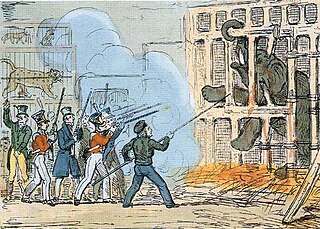 W
WChunee was an Indian elephant who was brought to Regency London in 1811.
 W
WThe Cremona elephant was a gift presented to Holy Roman Emperor Frederick II by Sultan of Egypt Al-Kamil, in 1229. Frederick used the elephant in his triumph parades.
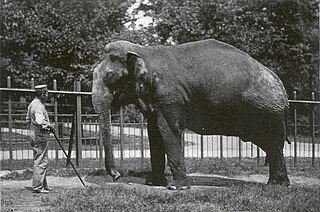 W
WDunk, a tuskless, male Asian Elephant possibly from Ceylon, was the first elephant to reside at the National Zoo in Washington, D.C. He was given to the National Zoo on April 30, 1891 by James E. Cooper, owner and manager of the Adam Forepaugh Circus.
 W
WGabi, also known as Boon-Chooi, is the first elephant conceived in Israel through artificial insemination. His 6-hour birth was viewed by over 350,000 people in 108 countries via live web streaming on the website of the Jerusalem Biblical Zoo, which coordinated the pregnancy and birth through its elephant artificial insemination program.
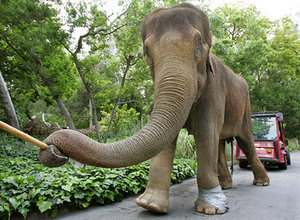 W
WGita was a 48-year-old Asian elephant who died at the Los Angeles Zoo on 10 June 2006. Gita's death prompted dozens of animal rights activists, including In Defense of Animals, to accuse the zoo of neglecting and endangering its animals by placing them in unsatisfactory living conditions, and fueled a years-long debate in the city government over the ethics of keeping elephants in a zoo at all.
 W
WGajarajan Guruvayur Keshavan is perhaps the most famous and celebrated temple elephant in Kerala, India. Keshavan was donated to the Guruvayur Hindu temple by the royal family of Nilambur on 4 January 1922. It is a common Hindu custom in Kerala to capture elephants either as calves or young adults from the wild and to donate them to the deity of the temple as an offering. Guruvayur temple currently has 47 elephants.
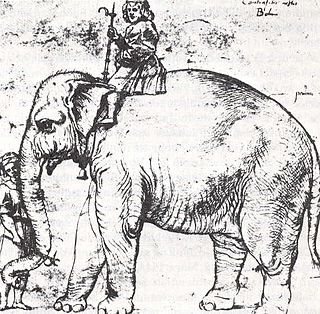 W
WHanno was the pet white elephant given by King Manuel I of Portugal to Pope Leo X at his coronation. Hanno, an Asian elephant, came to Rome in 1514 with the Portuguese ambassador Tristão da Cunha and quickly became the Pope's favorite animal. Hanno died two years later from complications of a treatment for constipation with gold-enriched laxative.
 W
WHansken was a female elephant that became famous in early 17th-century Europe. She toured many countries, demonstrating circus tricks, and was sketched by Rembrandt and Stefano della Bella.
 W
WHattie was an Asian elephant in New York City's Central Park Zoo that in 1904 was described as the "most intelligent of all elephants". In 1911, she was described as "nearly human".
 W
WHeiyantuduwa Raja (1924-November 6 2002) was a Sri Lankan elephant, which carried the Relic of the tooth of the Buddha casket in the Dalada Perahera for 11 years after the demise of Maligawa Raja. Heiyantuduwa Raja's tusks were each 7 ft 6 in (2.3 m) in length when he was living and it was considered as one of the longest-tusked elephants in the country.
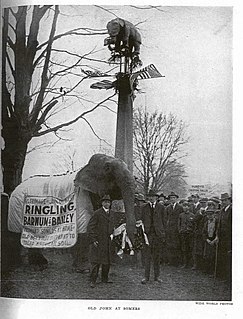 W
WJohn L. Sullivan,, was a tuskless male Asian elephant that performed in the Adam Forepaugh circus and, later, in the Ringling Brothers Barnum and Bailey Circus.
 W
WJumbo, also known as Jumbo the Elephant and Jumbo the Circus Elephant, was a 19th-century male African bush elephant born in Sudan. Jumbo was exported to Jardin des Plantes, a zoo in Paris, and then transferred in 1865 to London Zoo in England. Despite public protest, Jumbo was sold to P. T. Barnum, who took him to the United States for exhibition in March 1882.
 W
WKashin was an Asian elephant who spent most of her life at Auckland Zoo in Auckland, New Zealand. She arrived from Como Zoo in the United States in 1973 and remained at Auckland Zoo until her death.
 W
WKosik is a male Indian elephant in the Everland theme park in Yongin, South Korea, who was born in 1990. He made headlines in September 2006 when it was discovered he could imitate the Korean words for "yes" (네), "no" (아니오), "sit" (앉아), "lie down" (누워), and four other words. He makes the sounds by putting his trunk in his mouth and shaking it while exhaling, similar to the way a human whistles with fingers in their mouth. Kwon Su-wan, director of the zoo in Seoul, said: "We plan to conduct further studies with keepers, veterinarians and scientists on whether Kosik understands the meaning of these words as he speaks them."
 W
WLin Wang was an Indian elephant that served with the Chinese Expeditionary Force during the Second Sino-Japanese War (1937–1945) and later relocated to Taiwan with the Kuomintang forces. Lin Wang lived out most of his life in the Taipei Zoo and unquestionably was the most popular and famous animal in Taiwan. Many adults and children alike affectionately called the bull elephant "Grandpa Lin Wang."
 W
WLyuba is a female woolly mammoth calf who died c. 41,800 years ago at the age of 30 to 35 days. She is formerly the best preserved mammoth mummy in the world, surpassing Dima, a male mammoth calf mummy which had previously been the best known specimen.
 W
WMary, also known as "Murderous Mary", was a five-ton Asian elephant who performed in the Sparks World Famous Shows circus. After killing a keeper on his second day at work, in Kingsport, Tennessee in 1916, she was hanged in nearby Erwin.
 W
WMillangoda Raja (1938-30 July 2011)was a Sri Lankan elephant, which was considered as the longest tusked Asian elephant, when he was living. He was captured at Nawagaththegama jungles in Anamaduwa, Puttalam District in 1945 and thereafter was owned by M. R. A. Millangoda Appuhamy of Molagoda, Kegalle. Millangoda Raja participated at the Esala Perahera in Kandy for nearly 40 years and also carried the casket of tooth relic, an opportunity enjoyed by only a few elephants in Sri Lanka. The tusker died on 30 July 2011 and was about 73 years old at the time of his death. After his death the body of Millangoda Raja was Preserved and placed on public display in a museum, which was constructed by Ananda Millangoda at the Elephant Village in Molagoda, Kegalle.
 W
WMona was a 7,800 pound Asian elephant on exhibit at the Birmingham Zoo in Birmingham, Alabama. Mona's age was contested. According to zoo officials, she was born in the wild around 1947. An entry in a stud book maintained by the Association of Zoos and Aquariums gives an approximate birth year of 1951.
 W
W"Mr Tembo" is the fourth single released by English recording artist, songwriter and Blur/Gorillaz frontman, Damon Albarn, from his debut solo studio album Everyday Robots. Its release as a single was limited to the United States. The track features The Leytonstone City Mission Choir and contains a sample of "Lions", from the 1959 album Way Out Humor as written and performed by Richard Buckley. The track is produced by both Albarn and Richard Russell, whom Albarn had previously worked with on Bobby Womack's comeback album The Bravest Man in the Universe and on the DRC Music album, Kinshasa One Two.
 W
WNadungamuwa Raja is an Indian tusker born c. 1953 in Mysore and he is the current main casket bearer of the procession of Esala held in Kandy Sri Lanka. Nadungamuwe Raja is one of the tallest tuskers in Asia. Raja is one of the two elephant calves gifted by a Mysore Maharaja to the veteran native physician monk resided in Nilammahara Temple Piliyandala in appreciation of curing his relative's long lasted illness, other elephant being late Nawam Raja of Gangaramaya. In 1978 Nadungamuwa Raja was acquired from his second owner (Herbert Wickramasinghe by Dharmavijaya Veda Ralahamy of Nadungamuwa area, an eminent Ayurvedic physician of that time. Since then the elephant has been named after his residing village Nadungamuwa.
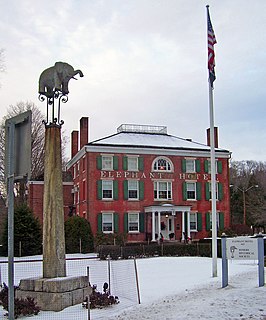 W
WOld Bet was the first circus elephant and the second elephant brought to the United States. There are reports of an elephant brought to the United States in 1796, but it is not known for certain that this was the elephant that was later named Old Bet.
 W
WOld Hannibal was a famous 19th century Asiatic elephant that was part of Isaac A. Van Amburgh's menagerie.
 W
WPacky was an Asian elephant at the Oregon Zoo in Portland, Oregon, United States. He was famous for having been the first elephant born in the Western Hemisphere in 44 years. At the time of his death, he was the oldest male Asian elephant in North America. With a shoulder height of 10 feet 6 inches (3.20 m) and overall height of more than 12 feet (3.7 m) when standing up straight, Packy was also one of the tallest elephants in the United States and perhaps one of the tallest worldwide.
 W
WPampady Rajan also written as Pambadi Rajan is one of the tallest elephants in Kerala. Pambadi Rajan has won Gajapattam including Gajarajan, Gajakesari, Gajarakthnam, Gajarajaprajapathi, Gajarajakulapathi, Gajaraja Lakshana Perumaal, GajarajaGajothama Thilakam, GajendraKarnan,etc and the rare award named Gajamaanikyam. no.1 position in fans. Pambadi Rajan was honoured with a new title SAARVABHAUMAN GAJARAJA GANDHARVAN by MAHANAVAMI COMMITTEE, Kodunthirapully Village, Palakkad on 21 October 2015. He was the winner in 2006 and 2007 of the Ithithanam Elephant Fest which is held in Ithithanam near Changanassery in Kottayam district. Recently visited Karavaloor Pooram at Peedika Bhagavathy Temple, Karavaloor, Kollam, Kerala on 25 March 2018.Rajan is SuperStar of all Kerala elephants. Since elephants are chosen to carry images of deities at temple festivals based on their stature and bearing, he was one of four elephants featured in life-size advertisements on the highway for a temple in Maradu.
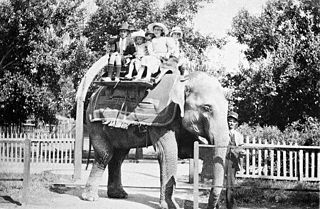 W
WQueenie was an elephant who was used to give rides for children at Melbourne Zoo for 40 years.
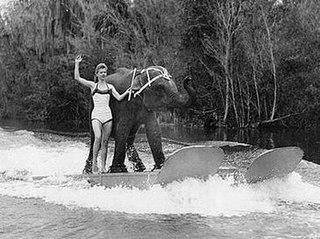 W
WQueenie was a captive female Asian elephant. She was noted in the late 1950s and early 1960s for waterskiing for entertainment.
 W
WRaja (1913 - 16 July 1988) was a Sri Lankan tusker elephant belonged to the Sri Dalada Maligawa, Kandy. Raja participated at the annual Esala procession in Kandy for around 50 years and was the sacred casket bearer of the final Randoli perehera for 37 years. He was one of the most celebrated elephants in Asia during his lifetime, and was world famous for his noble behavior. On 20 August 1986 former Sri Lankan President J. R. Jayewardene declared Raja as a national treasure, in recognition of his valuable services to the religion and culture of Sri Lanka.
 W
WRaja Gaj was a large Asian elephant that lived in the Bardiya National Park in Nepal. He was considered to be the biggest Asian bull elephant of modern times who was estimated to be 11 feet 3 inches tall at the shoulder, some two feet taller than the average Asian elephant. He went missing from his habitat in southwestern Nepal, in December 2007 and was never seen again. He was estimated to be 70 years old at the time of his disappearance.
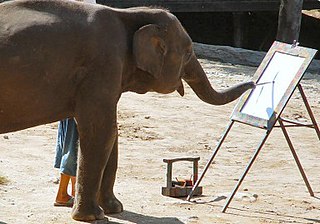 W
WRuby was a 4.5 ton Asian elephant that lived at the Phoenix Zoo and was famous for creating paintings. The most expensive of her paintings sold for $25,000.
 W
WSatao was one of Kenya's largest African elephants. He was known as a tusker because his tusks were so long that they almost touched the ground. The Tsavo Trust announced that Satao was killed by poachers using a poisoned arrow on 30 May 2014.
 W
WSuleiman was an Asian elephant that was presented to the Habsburg Archduke Maximilian II by King John III of Portugal and his wife, Catherine of Austria, Habsburg princess and youngest sister of the Emperor Charles V.
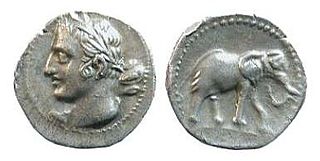 W
WSurus was believed to be the last war elephant of Carthaginian general Hannibal Barca's army in Italy.
 W
WThechikkottukavu Ramachandran is a elephant owned by Thechikottukavu devasom, a temple in Kerala. Ramachandran is the tallest elephant in Asia. Ramachandran is fondly known among elephant lovers as Raman and enjoys a huge fan following across Kerala.
 W
WThiruvambadi Sivasundar was an Indian elephant who lived at the Thiruvambadi Sri Krishna Temple in Thrissur, Kerala, India.
 W
WTopsy was a female Asian elephant who was killed by electrocution at Coney Island, New York, in January 1903. Born in Southeast Asia around 1875, Topsy was secretly brought into the United States soon thereafter and added to the herd of performing elephants at the Forepaugh Circus, who fraudulently advertised her as the first elephant born in America. During her 25 years at Forepaugh, Topsy gained a reputation as a "bad" elephant and, after killing a spectator in 1902, was sold to Coney Island's Sea Lion Park. When Sea Lion was leased out at the end of the 1902 season and replaced by Luna Park, Topsy was involved in several well-publicized incidents, attributed to the actions of either her drunken handler or the park's new publicity-hungry owners, Frederic Thompson and Elmer "Skip" Dundy.
 W
WTuffi was a female circus elephant that became famous in West Germany during 1950 when she accidentally fell from the Wuppertal Schwebebahn into the River Wupper underneath.
 W
WTyke was a female African bush elephant from Mozambique who performed with Circus International of Honolulu, Hawaii. On August 20, 1994, during a performance at the Neal Blaisdell Center, she killed her trainer, Allen Campbell, and seriously injured her groomer, Dallas Beckwith. Tyke then ran from the arena and through the streets of the Kakaʻako central business district for more than thirty minutes. Unable to calm the elephant, local police opened fire on the animal, which collapsed from the wounds and died. While the majority of the attack in the arena was recorded on consumer videotape by several spectators, additional professional video footage captured the attack on local publicist Steve Hirano and the shooting of Tyke herself.
 W
WYuka is the best-preserved woolly mammoth carcass ever found, currently displayed in Moscow, after having been discovered in 2014 in Siberia. The mammoth was found along the Oyogos Yar coast approximately 30 kilometers (19 mi) west of the mouth of the Kondratievo River, Siberia in the region of the Laptev Sea. Yuka is a juvenile female natural mummy that was found near and named after the village of Yukagir, whose local people discovered it. This mammoth mummy was found as an overhanging ledge about 4 meters (13 ft) above the beach level in a low wave-cut bluff that was about 5 meters (16 ft) high. After its discovery, Yuka spent two years stored and preserved in a natural refrigerator, the local permafrost (‘lednik’), at Yukagir. At that time, the first scientists, P. Lazarev and S. Grigoriev, from the Mammoth Museum arrived to study these mummified remains. By then, more than 100 meters (330 ft) of the low bluff had washed away. From Yukagir, the Yuka mammoth was transported to the Sakha Academy of Sciences in Yakutsk. Since October 2014, the mammoth has been on display in Moscow and is regarded as being the best preserved Siberian mammoth so far discovered.